Humongous iceberg might be on the move, say scientists
Loading...
As anyone familiar with the story of the Titanic knows, icebergs can pose a grave danger to ships.
That's why NASA is keeping a close eye on a large iceberg that broke off from the front of Antarctica’s Pine Island Glacier in November 2013.
"The ice island, named B31," notes the space agency in a statement, "will likely be swept up soon in the swift currents of the Southern Ocean, though it will be hard to track visually for the next six months as Antarctica heads into winter darkness."
“Iceberg calving is a very normal process,” said Kelly Brunt, a glaciologist at NASA’s Goddard Space Flight Center. “However, the detachment rift, or crack, that created this iceberg was well upstream of the 30-year average calving front of Pine Island Glacier (PIG), so this a region that warrants monitoring.”
The rift was first detected in the glacier in October 2011. The crack got bigger as the glacier was traveling faster than 2 miles every year. Later in 2013, infrared and radar images confirmed that the part had completely broken off from the main body of the glacier which has been thinning and draining rapidly, and may contribute to a sea level rise.
“It has been very interesting how little sea ice there has been in the area,” said Grant Bigg of the University of Sheffield who leads a research team involved in monitoring the ice field. In a time-lapse video showing the motion of the chunk of ice, one "can certainly see clouds suggesting strong katabatic wind flow off the glacier in the first month or two, which would have kept the Bay ice-free and helped guide the iceberg out," Dr. Bigg added.
Last year, researchers flew over the region and dropped 37 javelin-shaped GPS trackers called Aircraft Deployable Ice Observation Systems (ADIOS) onto the ice. The ADIOS are now helping them track the movement of the iceberg.
“We are doing some research on local ocean currents to try to explain the motion properly. It has been surprising how there have been periods of almost no motion, interspersed with rapid flow,” Bigg added. “There were a couple of occasions early on when there might have been partial grounding or collisions with the seafloor, as B31 bounced from one side of the Bay to the other.”
According to the latest available data provided by the US National Ice Center, B31 measures 18 by 11 nautical miles. “While some mass was lost very early on in the life of B-31, it has remained pretty much the same shape since early December and is still about six times the size of Manhattan,” Bigg said. “Going on measurements of Pine Island glacier before the calving—and hints of partial grounding in the history of the iceberg movement—we think it is possibly 500 meters thick.”








